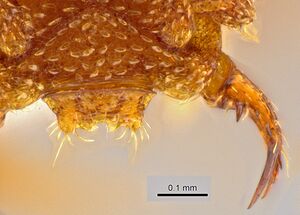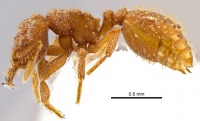Rhopalothrix andersoni
| Rhopalothrix andersoni | |
|---|---|

| |
| Scientific classification | |
| Kingdom: | Animalia |
| Phylum: | Arthropoda |
| Class: | Insecta |
| Order: | Hymenoptera |
| Family: | Formicidae |
| Subfamily: | Myrmicinae |
| Tribe: | Attini |
| Genus: | Rhopalothrix |
| Species: | R. andersoni |
| Binomial name | |
| Rhopalothrix andersoni Longino & Boudinot, 2013 | |
This species occurs in cloud forest, from 1300–1440m elevation. It is known from two montane sites: Sierra de Agalta in eastern Honduras, where it is sympatric with Rhopalothrix therion, and Cusuco National Park in northwestern Honduras. The three known specimens are from Winkler samples of sifted leaf litter. (Longino and Boudinot 2013)
Identification
Anterior labral lobe bilobed, with lateral lobule longer than medial lobule; masticatory margin of mandible with three teeth; squamiform setae of first gastral tergite abundant, short, 2 × longer than wide; HW 0.63–0.70.(Longino and Boudinot 2013)
Keys including this Species
Distribution
Latitudinal Distribution Pattern
Latitudinal Range: 14.93849° to 14.93512°.
| North Temperate |
North Subtropical |
Tropical | South Subtropical |
South Temperate |
- Source: AntMaps
Distribution based on Regional Taxon Lists
Neotropical Region: Honduras (type locality).
Distribution based on AntMaps
Distribution based on AntWeb specimens
Check data from AntWeb
Countries Occupied
| Number of countries occupied by this species based on AntWiki Regional Taxon Lists. In general, fewer countries occupied indicates a narrower range, while more countries indicates a more widespread species. |

|
Estimated Abundance
| Relative abundance based on number of AntMaps records per species (this species within the purple bar). Fewer records (to the left) indicates a less abundant/encountered species while more records (to the right) indicates more abundant/encountered species. |

|
Biology
|
Castes
The queen and male are unknown.
Images from AntWeb
    
| |
| Specimen code casent0629580. . | |
Images from AntWeb
 
| |
| Holotype Rhopalothrix andersoni. Worker. Specimen code casent0629582. Photographer Brendon Boudinot, uploaded by University of Utah. | Owned by CAS. |
Nomenclature
The following information is derived from Barry Bolton's Online Catalogue of the Ants of the World.
- andersoni. Rhopalothrix andersoni Longino & Boudinot, 2013: 308, figs. 1A, 2B, 3F, 5, 16 (w.) HONDURAS.
Unless otherwise noted the text for the remainder of this section is reported from the publication that includes the original description.
Description
Worker
HW 0.63–0.70 (n=3); mandible with three teeth on masticatory margin, second tooth from base largest; subapical tooth with distinct reclinate denticle at base; subapical tooth about 3 × as long as apical tooth; intercalary teeth distinct, one closest to apical tooth about half as long as apical tooth; labrum trapezoidal, anterior margin bilobed, lateral lobule triangular, longer than medial lobule, medial lobules rounded, flanking semicircular median notch; arcuate promesonotal groove and metanotal groove distinctly impressed; propodeal tooth large, acute, infradental lamella wide and forming a secondary convex lobe below tooth; squamiform setae abundant on first gastral tergite, uniformly covering entire tergite; gastral setae relatively short, 2 × longer than wide, tapering evenly from apex to base.
Type Material
Holotype, worker: Honduras, Olancho: 9 km N Catacamas, 14.93512 -85.90739 ±20 m, 1350 m, 11 May 2010, tropical montane forest, ex sifted leaf litter (R.S.Anderson#2010-025) California Academy of Sciences, unique specimen identifier CASENT0629582. Paratype (worker): same data, but 14.93849 -85.90665 ±20 m, 1440 m, 10 May 2010, mixed hardwood forest, ex sifted leaf litter (R.S.Anderson#2010-022) John T. Longino Collection, CASENT0629580.
Etymology
Referring to Robert S. Anderson, coleopterist extraordinaire.
References
- Longino, J.T. & Boudinot, B.E. 2013. New species of Central American Rhopalothrix Mayr, 1870 (Hymenoptera, Formicidae). Zootaxa 3616, 301-324.


